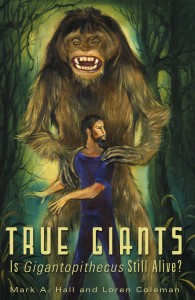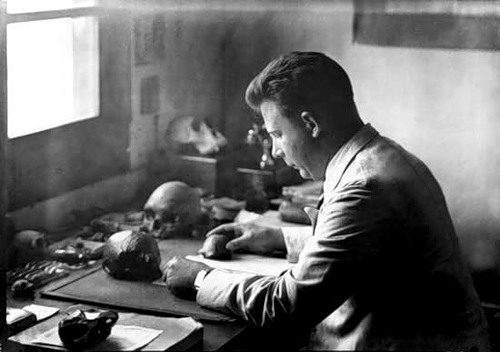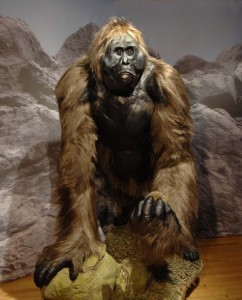Newton on Giants
Posted by: Loren Coleman on February 16th, 2011

True Giants—True Story? by Michael Newton
We’ve all heard stories of Bigfoot, Sasquatch, Yeti, Yowie—pick your moniker of preference. By any name, it’s said to be a hulking, hairy biped of six to nine feet tall, leaving trails of humanoid footprints fourteen to sixteen inches long. But what if there was something even bigger lurking in the wilderness? Let’s say a creature resembling Bigfoot but towering twelve to twenty feet tall, with feet twenty to thirty inches long.
It would, to say the least, be startling.
In fact, for generations there have been reports of truly massive “Bigfeet” seen in North America and all around the world. Coupled with claims of Sasquatch popping in and out of UFOs, they have embarrassed authors who treat cryptozoology as a serious discipline, but simply ignoring the hairy Goliaths hasn’t made them go away. Neither has the incessant ridicule heaped upon seemingly sober witnesses by sceptics and professional debunkers.

True Giants: Is Gigantopithecus Still Alive?
Now, at last, veteran cryptozoologists Mark Hall and Loren Coleman have tackled the problem head on, in their new book True Giants: Is Gigantopithecus Still Alive?? Their answer to that question is a qualified affirmative.
Hall coined the term “true giants” back in 1992, thirty-odd years after Ivan Sanderson proposed the prehistoric ape Gigantopithecus as a Bigfoot-Yeti candidate—or “neo-giant”—within a list of four proposed unknown hominid species worldwide. Sanderson, however, chose to skirt the issue of bipedal monsters twice the normal size ascribed to Sasquatch. Myra Shackley followed Sanderson’s lead two decades later in her book Wildman: Yeti, Sasquatch and the Neanderthal Enigma (1983; American title, Still Living?), while paleoanthropologists Russell Ciochon, John Olsen and Jamie Janes considered Bigfoot tangentially in their 1990 work Other Origins: The Search for the Giant Ape in Human Prehistory. Grover Krantz endorsed an evolved and altered species of Gigantopithecus as Bigfoot in 1992, naming it G. canadensis.

While most students of cryptozoology recognize “Giganto” as a favorite Bigfoot/Yeti candidate, many may be unaware that German anatomist-anthropologist Franz Weidenreich (1873-1948) renamed the creature Giganthropus, treating it as a primitive ancestor of Homo sapiens. Weidenreich’s view did not prevail against Edward Cope’s rule that population lineages tend to increase in size over evolutionary time, but dissenters persist—including authors Hall and Coleman, along with Australian cryptozoologist Rex Gilroy.
Whether or not readers of True Giants finally agree with their premise, Hall and Coleman rate kudos for collecting all the available evidence on “true giants” and reviewing it even-handedly. The final product is a handsome volume, featuring cover art by Alika Lindbergh (former wife of Bernard Heuvelmans) and twenty-three black-and-white illustrations, with all material fully sourced. Overall, True Giants is a valuable addition to the literature of Sasquatchery and natural mysteries.

This first appeared on forteanzoology.blogspot and was reproduced with the permission of Michael Newton.
About Loren Coleman
Loren Coleman is one of the world’s leading cryptozoologists, some say “the” leading living cryptozoologist. Certainly, he is acknowledged as the current living American researcher and writer who has most popularized cryptozoology in the late 20th and early 21st centuries.
Starting his fieldwork and investigations in 1960, after traveling and trekking extensively in pursuit of cryptozoological mysteries, Coleman began writing to share his experiences in 1969. An honorary member of Ivan T. Sanderson’s Society for the Investigation of the Unexplained in the 1970s, Coleman has been bestowed with similar honorary memberships of the North Idaho College Cryptozoology Club in 1983, and in subsequent years, that of the British Columbia Scientific Cryptozoology Club, CryptoSafari International, and other international organizations. He was also a Life Member and Benefactor of the International Society of Cryptozoology (now-defunct).
Loren Coleman’s daily blog, as a member of the Cryptomundo Team, served as an ongoing avenue of communication for the ever-growing body of cryptozoo news from 2005 through 2013. He returned as an infrequent contributor beginning Halloween week of 2015.
Coleman is the founder in 2003, and current director of the International Cryptozoology Museum in Portland, Maine.









